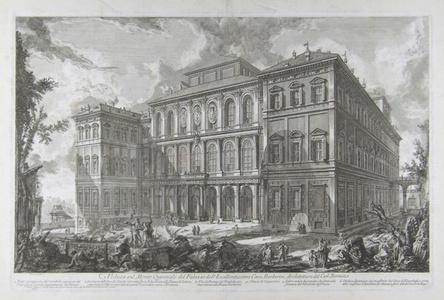| Method | Etching |
| Artist | Giovanni Battista Piranesi |
| Published | Piranesi fece. Presso l'Autore a Strada Felice nel palazzo Tomati vicino alla Trinita de'monti. A paoli due e mezzo. [Rome, 1760-1778] |
| Dimensions | Image 378 x 610 mm, Plate 405 x 618 mm, Sheet 525 x 736 mm |
| Notes |
Inscription below title reads: '1. Ponte levatojo, che dal vestibolo superiore da l'ingresso al Secondo Appartamento del Palazzo. 2. Inscrizione dell'Arco di Claudio ritrovata fra le di lui rovine alla Piazza di Sciarra, e dinotante le Vittorie riportate da questo Imperadore sopra i Britanni. 3. Uno de' Portoni del Vestibolo, corrispondente alla Piazza Barberini. 4. Chiesa de'Cappucini. 5. Labro antico di granito, che serve alla fontana del Vestibolo inferiore. 6. Obelisco Egizziaco, ivi transferito dal Circo d'Elagabalo, o come altri vogliono d'Aureliano, che rimaneva fuori dell'odierna Porta Magge.' A view of the Palazzo Barberini from Piranesi's Vedute di Roma. The view takes full advantage of the impressive facade of the palace, constructed to a design by Bernini. In the foreground, Rome's citizens walk and rest among the remains of Roman antiquity, including the fragments of the Pinciano obelisk which lie to the left of the scene. Although in the Egyptian style, and heavily ornamented with hieroglyphs, the Pincian obelisk was actually constructed in the reign of Hadrian, and erected as a funerary monument for Antinoos at Tivoli. It was moved to Rome by Elagabalus, and stood upon the spina of the Circus Varianus, before being rediscovered near the Porta Maggiore in the sixteenth century. The Vedute di Roma was Piranesi's most popular and best known series, celebrating the churches, monuments, ruins, bridges, fountains, and public spaces of the city of Rome. The immense popularity of the series meant that they were in constant demand, and Piranesi continued to reissue and add to the series from the 1740s until his death in 1778. The Vedute were particularly popular with British grand tourists, and had a profound effect on the British Neoclassical movement. Demand was such that the series was reprinted numerous times after Piranesi's death, including two Paris editions published by his sons, Francesco and Pietro. Giovanni Battista (also Giambattista) Piranesi (1720 – 1778) was an Italian artist famous for his etchings of Rome and of fictitious and atmospheric "prisons" (the Carceri d'Invenzione). He was a major Italian printmaker, architect and antiquarian. The son of a Venetian master builder, he studied architecture and stage design, through which he became familiar with Illusionism. During the 1740's, when Rome was emerging as the centre of Neoclassicism, Piranesi began his lifelong obsession with the city's architecture. He was taught to etch by Giuseppe Vasi and this became the medium for which he was best known. Hind 25.ii/v, Wilton-Ely 188, Focillon 740, C726 Condition: Strong impression with wide margins. Central vertical fold. Printer's creases to margins, not affecting plate or image. |
| Framing | unmounted |
| Price | £1,600.00 |
| Stock ID | 42292 |

